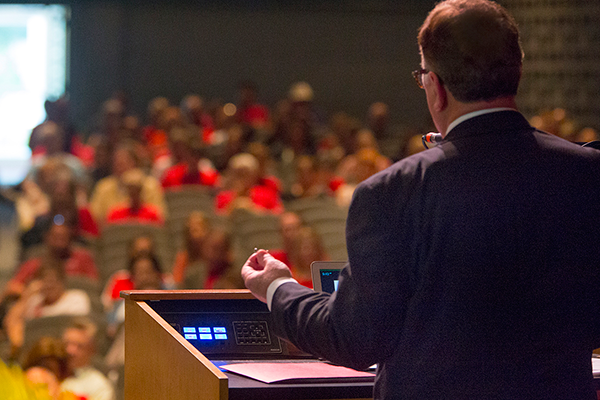Despite eight consecutive years of state budget cuts that have resulted in the largest shift in revenue sources for higher education in state history, the University of Louisiana at Lafayette continues to protect its academic core.
UL Lafayette received two-thirds of its funding from the state eight years ago, Dr. Joseph Savoie, UL Lafayette president, said Friday. This year, state funding fell below 30 percent, he told faculty and staff in an annual address.
“This dramatic change in the funding paradigm created significant challenges, but we met the challenges head-on. We didn’t whine or whimper. We implemented strategies to increase self-generated revenues and protect the core academic mission of the University,” he said.
UL Lafayette's new financial model relies on more auxiliary business operations, research funding and private philanthropy.
The University’s budget for fiscal year 2016-17 is comparable to its fiscal year 2015-16 budget. In fiscal year 2015-16, the budget was $161.2 million. For fiscal year 2016-17, it is $161.6 million – if there are no mid-year cuts in state funding.
“For the first time in many years, the budget is stable,” Savoie said.
One of the primary reasons the University’s budget has remained steady is “because of aggressive efforts to grow enrollment, in both quantity and quality. Following a slight dip a few years ago caused by raising our admissions requirements, we’ve had solid growth,” Savoie explained.
Despite a significant increase in student enrollment, he said, “we’ve been able to hold our student-to-faculty ratio steady at 22-to-1. It’s the same today as it was in 2008.”
Changes to the state’s TOPS funding could affect future enrollment.
“A new law capped future award increases, which means TOPS may not match future tuition rates. In the event of future state budget shortfalls, another law requires all TOPS awards to be reduced on a pro-rata basis.
“For this year, due to shortfalls of state funding, TOPS was not fully funded. TOPS was funded at 93 percent for this semester and is only funded at 47 percent for Spring 2017. That leaves many students, across Louisiana, having to make up the difference. This has implications for University-funded scholarship offerings,” Savoie said.
He noted that the University raised $15 million in private funds during fiscal year 2016 and increased the number of donors by nearly 11 percent over the previous year.
The University also has made significant progress in distance learning. It now offers 11 online degree programs and 287 online courses. “We’ve tripled the number of online and hybrid sections offered in five years,” Savoie said.
In another effort to combat dwindling state revenue for higher education, UL Lafayette has developed its own capital outlay program for campus improvements. The University has a backlog of $37.5 million in major repairs that are needed.
“Many of the improvements are about function rather than cosmetics. For example, we need to replace air conditioning units, windows and roofs, flooring, ceiling tiles and do lots of painting,” he said.
Another project, which will be funded by students’ self-assessed fees, will be an outdoor amphitheater adjacent to the Student Union and Cypress Lake. “We are working with student leaders and architects to complete the unfinished area,” Savoie said.
Caption: UL Lafayette President Dr. Joseph Savoie addresses faculty and staff Friday.
Photo by Doug Dugas
